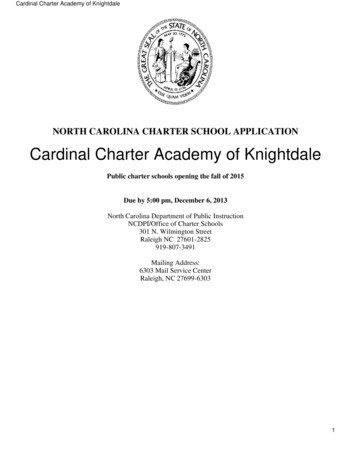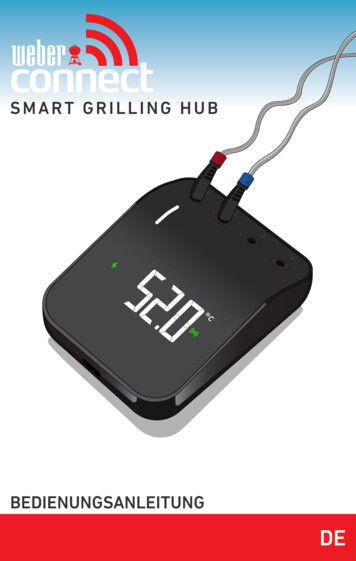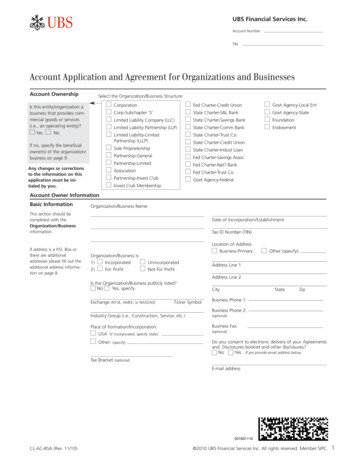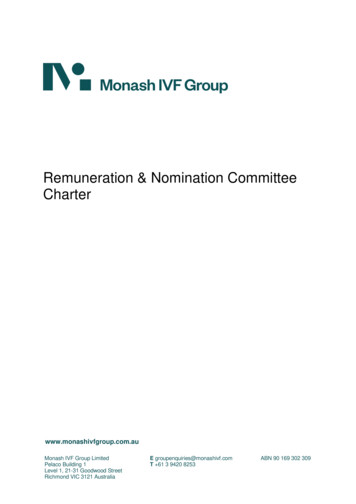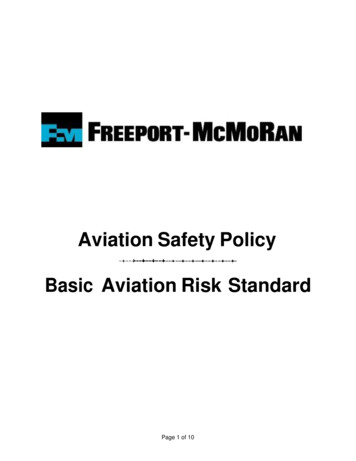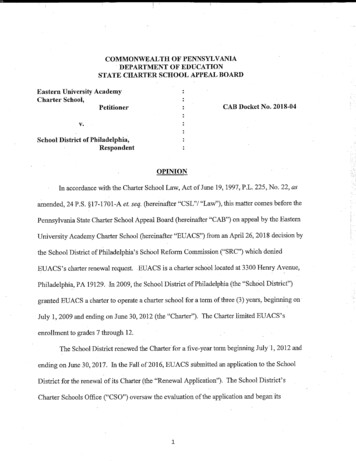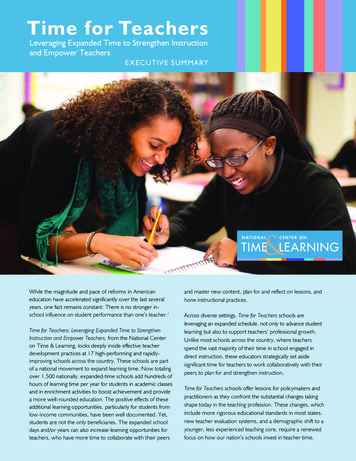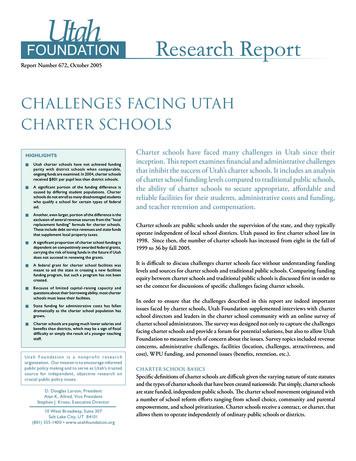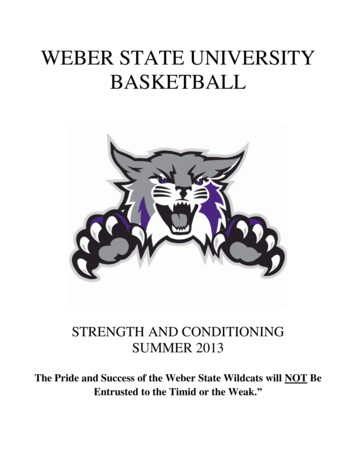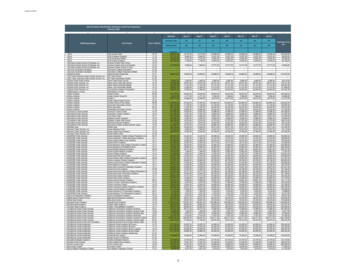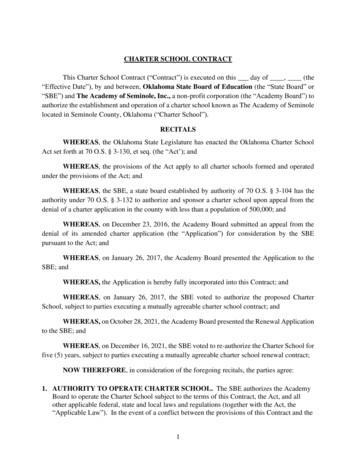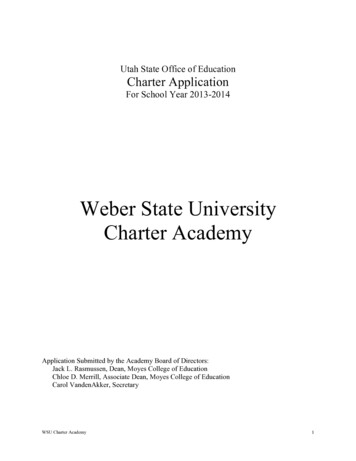
Transcription
Utah State Office of EducationCharter ApplicationFor School Year 2013-2014Weber State UniversityCharter AcademyApplication Submitted by the Academy Board of Directors:Jack L. Rasmussen, Dean, Moyes College of EducationChloe D. Merrill, Associate Dean, Moyes College of EducationCarol VandenAkker, SecretaryWSU Charter Academy1
REQUIRED INFORMATIONAll information presented in this application becomes part of the charter agreement as defined in BoardRule R277-481 and may be used for accountability purposes throughout the term of the charter contract.I.Charter School Information1. Name of proposed charter school:2. Name of applicant:3. Authorized agent:Weber State University Charter Academy (WSUCA)Chloe D. Merrill, Ph.D., Associate Dean, Moyes College of EducationJack L. Rasmussen, Ph.D., Dean, Moyes College of Education4. Mailing address: Weber State University Charter Academy, c/o Dr. Chloe D. Merrill, 1031University Circle, Weber State University, Ogden, UT 84408-13015.Phone number: 801-626-71106.Email address: cmerrill@weber.edu7.District(s) where proposed charter school is located in the Ogden School District but will bechartered as Weber State University – Institution Charter8.District contact(s) and date complete application submitted to district(s). (NOTE: repeat thisstatement for each district in which the school may be located.)Submitted to Brad Smith (person) who works at Ogden School DistrictSchool District on July 16, 2012 (date).9.Form of organization (check) Nonprofit Corporation Tribal entity Other10. The governing body of a charter school is responsible for the policy decisions of the school.Please indicate the makeup of this body below. (Add lines as necessary)Jack L. Rasmussenjrasmussen@weber.eduType ofMember (e.g.,parent,business)EducatorChloe D. Merrillcmerrill@weber.eduEducatorCarol aEmail11. Year school will start: 2013-2014WSU Charter Academy12.Position on Board (e.g., chair,secretary)Dean – Moyes College ofEducation/ PrincipalAssociate Dean –Moyes Collegeof Education/AssociatePrincipalSecretary/Business AdministratorNumber of instructional days: 1802
13. Grades served: Kindergarten (K)14.Hours of instruction: 50415. Projected Enrollment (Complete growth model through the appropriate operational years):Operational Year 1: Total: 40 Grades K-6: 40 , Grades 7-8: 0 , Grades 9-12: 0Operational Year 2: Total: 44 Grades K-6: 44 , Grades 7-8: 0 , Grades 9-12: 0Operational Year 3: Total: 44 Grades K-6: 44 , Grades 7-8: 0 , Grades 9-12: 0Operational Year 4: Total: 44 Grades K-6: 44 , Grades 7-8: 0 , Grades 9-12: 0Operational Year 5: Total: 44 Grades K-6: 44 , Grades 7-8: 0 , Grades 9-12: 0Ultimate enrollment: Total: 44 Grades K-6: 44 , Grades 7-8: 0 , Grades 9-12: 0Does proposed grade configuration match resident district grade configuration? Yes No16. Target percentage of students with an IndividualizedEducation Plan: 10%17. Target percentage of students identifiedas minority: 10%18.19. Is this a conversion? Yes (include required signatures andproof of local board approval inSection 19) No20.Target percentage of students qualifying for freeor reduced lunch (i.e., economicallydisadvantaged): Although we will not be servinglunch, we will not exclude students who might beeconomically disadvantaged. Projectedeconomically disadvantage student populationmight be 10 percent. No students will be excludedbased on financial need.Does the charter school intend to participate inUtah Retirement System? Yes NoThis would depend on the people hired andwhat they work out with Human ResourcesWSU Charter Academy21. A charter school may apply to the StateBoard of Education for a waiver of any rulethat inhibits or hinders the school fromaccomplishing its mission or educationalgoals set out in its charter. List any waiverrequests here (i.e., Rule numbers. Providedetails regarding the need for the waiver asAppendix I). N/A3
22.List persons whom you have designated as Founding Members of the school. Children of aFounding Member (an individual who has had a significant role in the development of a charterschool application), children of an employee, and siblings of students currently attending thecharter school are eligible for preferential enrollment under both State and Federal Charter Schoollaw. Also, identify the percentage of students eligible for preferential enrollment under the status offounder’s child or employee child.Jack L. RasmussenChloe D. MerrillCarol VandenAkkerCamie BeardenFran ButlerClaudia EliasonCarole HaunJared LisonbeeJack MayhewCarrie OtaWei QiuPeggy SaundersPaul SchvaneveldtSherrie WestRay WongWSU Charter Academy4
II.AssurancesThe applicant charter school hereby assures and certifies to the Utah State Charter School Board and UtahState Board of Education that: Read and Check The charter school will make provision for such fiscal control, fund and program accountingprocedures as may be necessary to assure proper disbursement and accounting for all funds, andwill utilize fiscal procedures that are consistent with generally accepted standards of fiscalmanagement. The charter school will not expend program funds for any education program, activity, or servicerelated to sectarian instruction or religious worship. The charter school assures that resources will be available and a process established to develop aStudent Education Plan/Student Education Occupation Plan (SEP/SEOP) for each student. The charter school will maintain an active parent/guardian involvement process including someformal mechanism for meaningful involvement in site-based decision making. The charter school will not charge tuition or fees, except those fees allowed by law. GoverningBoards will adopt allowable fees annually in an open board meeting. A copy of the charter will be supplied to interested individuals or groups on request. The charter school will be fully accredited no later than its third year of operation. The charter school will acquire and maintain nonprofit corporate status. The charter school will acquire and maintain all required insurances, including General LiabilityCoverage for both Bodily Injury and Property Damage Liability at 2 million per occurrence;perhaps, with an annual aggregate amount; Automobile Liability Coverage for Bodily Injury andProperty Damage at 2 million per occurrence including PIP coverage; Personal Injury / CivilRights Coverage for claimed Constitutional violations and claimed violations of federal and statelaw at 2 million per occurrence; Errors and Omission Coverage for, among other things, actionstaken by directors and board members who govern the school at 2 million per occurrence;Government Crime Policy including employee theft, faithful performance, and coverage foremployee and officer bonds; Property Coverages - probably a standard all-risk property policywith possible endorsements for Business Interruption, Extra Expense and Tuition Fee coverage;Workers' Compensation Coverage at such amounts and limits as required by Utah law; andTreasurer’s Bond. If coverage will be provided outside of State Risk Management, applicantprovides a letter from the tentative insurer indicating a willingness to provide the coveragementioned above and includes it in Section 19. The charter school will maintain accurate student transcripts. The charter school is nonsectarian in its programs, admission policies, and employment practicesand all other operations. The charter school Principal/Director shall attend a one-day special education training classsponsored by the Utah State Office of Education prior to the first day of instruction and annuallyWSU Charter Academy5
WSU Charter Academy6
Table of ContentsSection 1 – School Purpose and Goals .10Section 2 – Student Population .15Section 3 – Calendar and Bell Schedule .18Section 4 – Market Analysis .19Section 5 – Capital Facilities Plan .22Section 6 – Detailed Business Plan and Budget .23Section 7 – Fiscal Procedures .26Section 8 – Organization Structure and Governing Body .31Background Information Sheet – Jack L. Rasmussen .33Background Information Sheet – Chloe D. Merrill .35Background Information Sheet – Carol VandenAkker .38Background Information Sheet – Camie J. Bearden .39Background Information Sheet – Francis M. Butler .41Background Information Sheet – Claudia F. Eliason .42Background Information Sheet – Carole J. Haun .44Background Information Sheet – Jared Lisonbee .46Background Information Sheet – John (Jack) C. Mayhew, Jr. .48Background Information Sheet – Carrie L. Ota .50Background Information Sheet – Wei Qiu .53Background Information Sheet – Peggy J. Saunders .55Background Information Sheet – Paul Schvaneveldt .57Background Information Sheet – Sherrie West .58Background Information Sheet – Raymond E. Wong .60Note Concerning Affidavit, Disclosure, and Consent for Background .61Pages 62-91 are on file in the WSU Charter Academy OfficeMinutes from Founding Members Planning Meeting 5-4-12 .92Minutes from Founding Members Planning Meeting 6-11-12 .96Section 9 – Comprehensive Program of Instruction .97Section 10 – School Closure Plan .102Section 11 – Dismissal Procedures and Suspension/Expulsion .105Section 12 – Complaints .107Section 13 – Parental Involvement .109Section 14 – Employees .111WSU Charter Academy7
Section 15 – Services .118Section 16 – Extra-Curricular Activities .128Section 17 – Special Education.129Section 18 – Additional Information .131Appendix A – Charter Academy Lottery Policy .132Appendix B – Budget Form .134Appendix C – Purchasing Policies and Procedures .144University Procurement/General (PPM 5-25a) .144Requisition Preparation and Processing (PPM 5-25b).150Small Purchases and Emergency Procurement (PPM 5-25c) .152Restricted Purchases and Special Procurement (PPM 5-25d) .154Solicitation of Bids, Proposals and the Award of Procurement Contracts (PPM 5-25e) .157Lease or Rental of Property for University Use (PPM 5-25f) .164Receiving (PPM 5-25g) .168Procurement From Vendor in which University Employee (PPM 5-25h) .169Purchasing Cards (PPM 5-25i) .173Stores (PPM 5-26) .180Surplus Property (PPM 5-27) .181Fixed Asset Accounting (PPM 5-28) .183Mail Service (PPM 5-30) .186Food Services (PPM 5-30a) .188Appendix D – Suspension/Expulsion Policy .190Appendix E – School Complaint Policy .208Appendix F – Conflict of Interest and Employment of Relatives .210Employment of Relatives (PPM 3-6).210Staff Employee Grievances (PPM 3-31).211Discrimination and Harassment (PPM 3-32) .216Faculty Responsibilities to Students (PPM 9-5) .226Due Process/Definition of Terms (PPM 9-10).228Informal Procedures and the Informal Conciliatory Meeting (PPM 9-11) .231Appendix G – Acceptable Use & Social Media Policy (PPM 10-2) .234Appendix H – Extra-Curricular Activities Policy.240Appendix I – WSUCA IDEA Policies and Procedures .241Appendix J – List of Administrative Rules.275WSU Charter Academy8
This page is blankWSU Charter Academy9
Section 1 - School Purpose and GoalsA. EXECUTIVE SUMMARYMission StatementThe mission of the WSU Charter Academy is to provide an educational learning center with anemphasis on student learning and family involvement; where WSU pre-service teachers mayobserve and practice cutting-edge, research-based educational practices; and where research onvarious aspects of education may be conducted.The Weber State University Charter Academy (WSUCA) is focused on educating the wholechild using developmentally appropriate and research supported curricula and instructionalmethods. The WSU Charter Academy will draw its students from the surrounding affiliateddistricts specifically Ogden School District and from the WSU student and faculty community.Conceptualized by a group of educators from the Moyes College of Education, the CharterAcademy has a vision of faculty, students, and families working in concert to develop thecapacities of the whole child – academically, socially, emotionally, and physically.In today’s educational climate precipitated by the perceived demands of test scores andaccountability, many instructional programs in the surrounding community have become morenarrowly defined, as observed by members of the founding committee. Most often as the keyfounders have observed instruction in kindergarten and beyond, developmentally appropriatepractice has been abandoned in favor of unconnected, drill and practice methods that educatorsin the surrounding districts believe to be expedient to meet their district’s expectations. With thelopsided attention to academic attainment, as measured by test scores, very little time is spent onother facets of development The WSU Charter Academy founders believe that the goals of NoChild Left Behind (NCLB) standards and accountability are compatible with developmentallyappropriate practices and educating the whole child. The collective expertise of the committeeincludes child development, preK-12 and university teaching, administration, research;curriculum development, educational psychology, and instructional strategies; special educationand English as a second language. These areas of expertise combine to enable the academic andaccountability goals of NCLB to be attained in a developmentally appropriate educationalprogram that attends to the academic, social, emotional, and physical needs of students – thewhole child.B. MISSION SPECIFIC GOALSThe Weber State University Charter Academy asserts three goals:1. Maintaining a focus on children and families through educational, co-curricular, andextra-curricular programs;2. Providing training in research informed practices for pre-service teachers throughobservation and mentored teaching opportunities;3. Providing a research center through opportunities for University faculty, Universitystudents, and WSU Charter Academy faculty to study various educational aspects.WSU Charter Academy10
Goal 1:This goal derives from the philosophy subscribed to in the educational programs at WSU CharterAcademy, which is child-centered, developmentally appropriate, and oriented toward thedevelopment of the whole child. Individual students take precedence over programs, whilemaintaining standards of achievement. Issues in any area of development will be examined inlight of student and family needs. This program believes that family support is integral to studentsuccess. The WSU Charter Academy recognizes that when parents participate at school, providea positive attitude toward learning at home, and work in concert with educational personnel,students are more successful academically and socially. To that end, the educational programinvites parent participation and will provide opportunities for family members/student caregiversto extend the school program into the home in appropriate ways. This may include classroomparticipation by adult family members in order to have models of appropriate practice; familynights at school focused on subject matter activities that family members and students mayparticipate in together, providing ideas that may be used at home; formal learning opportunitiesfor adult family members to learn about parenting, educational development, child development,or similar classes of interest.Evidence of meeting Goal 1 will be found in matching the educational program components withprinciples set forth by the National Association for the Education of Young Children (NAEYC)for developmentally appropriate practice, produced annually; in student records documentingprogress and program adjustments, reported annually; in school records of events and coursesoffered, with statistics on participation, reported annually; and in the parent participation logbook, detailing the number of hours parents spend in school and classroom activities, reportedeach semester.Goal 2:Providing training in research informed practices for pre-service teachers coincides with WSUMoyes College of Education’s primary mission: to train teachers. The WSU Charter Academywill provide classrooms in which WSU pre-service teachers may observe the research-basedpractices they have heard and read about in coursework. Observation may take place directly inthe classroom, from the observation booth attached to the classroom, or from videos made ofclassroom activities. Under close supervision, pre-service teachers may receive mentoring anddirect opportunity to practice teaching under conditions that reflect what they have learned intheir courses.Evidence of meeting Goal 2 will be found in the number of students involved in observations orpractice teaching; in the evaluation forms students complete during the observations; and in otherassessments associated with assignments of pre-service teachers to the WSU Charter Academy.These evidences will be reported for each WSU academic term.Goal 3:Providing a facility at which educational research may be carried out. The WSU CharterAcademy will provide a place in which university faculty, pre-service teachers, graduatestudents, and in-service teachers may research instruction and instructional programs, childdevelopment, curriculum design and assessment, etc. to further their individual knowledge and toadd to the knowledge base of what works in the classroom.WSU Charter Academy11
Evidence for meeting Goal 3 will be found in the number of pre-service and graduatepresentations, projects, and publications prepared, as well as in the number of presentations andpublications university faculty produce. These evidences will be reported annually.C. PURPOSEThe purposes of the WSU Charter Academy are threefold:1. To meet community needs through increased parental choice with a family oriented,child-centered curriculum;2. To improve student learning through a developmentally appropriate curriculum thatincludes high standards and expectations for learning as well as individual support; and3. To study innovative teaching methods, measurement, and other components of educationin order to contribute to the national and international body of research-based knowledge.The WSU Charter Academy will meet the purpose of charter schools defined in Title 53A-1a-503.Indicator – Upholding mission and purposeMeasureDevelopmentally AppropriatePracticesUtah Core Curriculum StateStandards (CCSS)MetricPercentage of programcomponents meeting NAEYCstandardsPercent of children meetingKindergarten standards in mathand reading as documented byplanned observational assessmentand portfolio work samplesBoard Goal80% year one90% there after80% of children will meet eachindividual Core Curriculum StateStandard75% of families will participateParental participationPercentage of familiesparticipating and the documentedhours of participationTraining of pre-service teachersPercentage of pre-serviceteachers’ who will have hadobservations & participationwithin Kindergarten classroom100% of Teacher Education LevelI StudentsResearch opportunities for preservice teachers, graduatestudents, and faculty membersNumber of presentations,publications, and projectscompleted by the target groupsA minimum of 5 presentations,publications, and /or projects willbe complete per year by the targetpopulationsWSU Charter Academy50% of families will participate atthe 30 hours per year level12
Improve student learning by: Setting goals and meeting them Developing a community of learners Ensuring decision making concerning students is grounded in the dignity of each student Offering developmentally appropriate curriculum and instruction Expecting homework to be either practice of what a student has been taught or anextension activity or project Provide access to technology and online resources including e-books, research, learningsites, online communities, tools for presentations, student targeted planning, tracking andassessment models and tools Student support through small group tutoring by teaching assistants, parents, and teachersInnovative teaching methodsWSU Charter Academy will encourage innovative teaching methods through professionaldevelopment and the mentoring program to motivate teachers as a community of learners.Professional development efforts will target the following three areas: Legal and Professional Obligations Instructional Practices and CurriculumIncreasing knowledge of content or subject and learning new teaching strategiesor assessment procedures Student DevelopmentSocial, emotional, and physical growth of students, classroom management skillsTargeted professional development will meet the needs of the following recipients Grade levels, Departments, Special Education, Title 1 or vertical teams of teachers Teaching assistants Individual staff members – identified areas for growth Leadership – Board, administration, counselor, Case Management Team, LeadershipTeamTeachers will be encouraged to share strategies, develop curriculum materials together, andsupport each other in the classroom. WSU Charter Academy professional development willfocus on teaching practices that have a direct correlation to student success. The regular analysisof student outcome data and the adjustment of the instructional practices are key to an effectivelearning community. WSU Charter Academy teachers will use effective teaching methods andmodels of instruction, incorporating research-based innovations aligned with improved learningoutcomes. Reeves (The Learning Leader, ASCD, 2006) warns that many education systemshave reverted to large numbers of required statistical information systems and student datacollection to monitor the effectiveness of teachers in the classroom. When in fact, teachers whopossess the ability to look at current and relative data and implement daily practices to improvestudent learning are most successful.Increase choice of learning opportunities for students Students will learn the process of identifying a problem, generating possible solutions,selecting the best solution and implementing problem solving throughout the curriculumWSU Charter Academy13
Students will work collaboratively in cooperative learning groups. Cooperative learninggroups will be used to develop peer interactions, leadership skills, and cooperation.All students will engage in service learning and develop a sense of civic responsibilitythrough service experiences and reflection activities.Students will work in an environment where teachers may focus their time on teachingand learning and the parent organization will support activities.References for Section 1CReeves, D. B. (2006). The Learning Leader: How to Focus School Improvement for BetterResults. Alexandria, VA: Association for Supervision & Curriculum Development.WSU Charter Academy14
Section 2 – Student PopulationA. TARGET POPULATIONKindergarten students of parents who prefer developmentally appropriate practices (DAP) asdefined by NAEYC along with the Common Core State Standards (CCSS) in education are thetarget population for this school. The majority of students would come from Ogden City and thegreater Ogden area.B. SPECIAL POPULATIONSStudents with special educational needs (i.e., English language learners, 504 eligible students,gifted & talented, economically disadvantaged, etc.) would be welcomed. Because this academywill have the support and resources of the WSU Moyes College of Education – specifically theChild and Family Studies and Teacher Education departments and faculties who are trained andlicensed to support students in these populations – provisions and services will be readilyavailable.English as a Second Language (ESL): Often ESL students have educational experiences thatchallenge their individual educational development. Strategies to effectively instruct individualESL students will be utilized. Cooperative learning, which will be implemented at WSU CharterAcademy, is one such research-based strategy proven to increase the involvement of Englishlanguage learners in classroom activities.504 Eligible Students: WSU Charter Academy founders understand the requirements of Section504 in the school setting and will ensure that all requirements of that law are obeyed, includingaccommodations which enable students to receive the benefits of this public school.Health Care Plans (IHP): Individual Health Care Plans are written to address the health needsof specific students while they attend school. WSU Charter Academy’s administration and staffwill be responsible to follow the individual student’s health care needs, including the services toaccommodate health conditions of students within the IHP guidelines.Economically Disadvantaged: Tracking and assistance will be evaluated for students andfamilies for this group. Every effort will be made to coordinate with local agencies to assistthese students and their families.Gifted and Talented: Gifted means students who perform or show potential for performing atremarkably high levels of accomplishment when compared to others of their own age. Thesestudents’ needs will be identified and supported at WSU Charter Academy (Delisle & Lewis,2003).WSU Charter Academy15
Studen
All information presented in this application becomes part of the charter agreement as defined in Board Rule R277-481 and may be used for accountability purposes throughout the term of the charter contract. I. Charter School Information 1.Name of proposed charter school: Weber State University Charter Academy (WSUCA)
